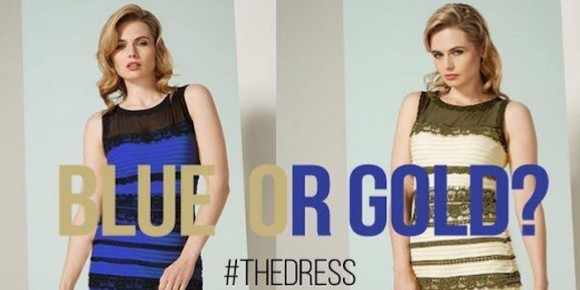A couple of weeks ago there was a fierce debate online about the color of a dress. It all began with a post “Guys, please help me – is this dress white and gold, or blue and black?” from a 21-year-old singer Caitlin McNeil. After that, the color of the dress became a worldwide debate.

This is the dress! From http://www.dogonews.com/2015/3/6/white-and-gold-or-blue-and-black-the-great-dress-debate
People generally held two ideas. Some of them saw white and gold, and the others saw blue and black. I was with three friends when we saw the picture of this dress. Three of us saw blue and black, and the other one saw white and gold. After we knew the color each others saw, confirmation bias occurred. According to Wason (1960), confirmation bias is the tendency people seek information which supports their favored positions and ignore disconfirming information (Schneider, Gruman & Coutts, 2012, p.240). The three of us who saw blue and black started talking about how the dress should be blue and black and the other one who saw white and gold seemed little ignored.
During the dress talking most of us thought the dress is “definitely blue and black” and “how could those people ever see white and gold”. This is typical representativeness heuristic. In this case individuals are perceived to represent most people that they thought the dress should be blue and black in truth.
After a period time of the debate, there was scientists online explained the process how people saw this dress in different colors. The difference was because of differed light sensitivity of eyes and differed initial rays when the photo is taken (Farrell, 2015). Also, it turned out that the dress is actually blue and black according to its manufacturer. When we found that some of us stated “I knew it!” and said they knew the dress is truly blue and black for sure, even though one of them previously doubted maybe the dress is white or even red. This confirms hindsight bias which is the tendency people would believe that an event is more predictable than it actually was (Schneider, Gruman & Coutts, 2012, p.240).
Have any of you got the same reaction in the dress color debate before? If you are interest in details about the debate, here is a video about it. Enjoy!
Reference
Frank W. Schneider; Jamie A. Gruman & Larry M. Coutts. (2012). Applied Social Psychology. p.240-241. Sage.
Jennifer Farrell.(2015).’ White And Gold Or Blue And Black? The Great Dress Debate!’ DOGO News. Website:
http://www.dogonews.com/2015/3/6/white-and-gold-or-blue-and-black-the-great-dress-debate
ABC News. (2015). Speed Feed: Is This Dress Gold and White, or Blue and Black? Youtube. https://www.youtube.com/watch?v=zfmkYsd3QDI

Oh the dress debate. I always find things like that fascinating. In fact, it confirmed a questions I have ad since I was a small child, which was “If you and I both look at something blue, do we both perceive the same color?” Apparently not always. What I think was even more interesting was the social aspect of the #thedress phenomenon. Why did so many people care at all what color the dress was in this poorly taken photo? I would dare to argue that what drove this media frenzy was cognitive dissonance. We each had our own beliefs regarding what we perceived the dresses color to be. Once other’s viewing the same image emphatically argued to the contrary, it created dissonance between our expectations that others would view the dress in the same way we do. The feelings of discomfort and unease we experience due to this dissonance helped propel this picture of a dress around the world.
Watching the video, I see this dress as white and gold. There was a really interesting show that explained that color was a concept generated by your brain. I remember an earlier psychology class had made that same point of color being a concept of your mind and that was why you dream in color. That particular thought did not sit well with me. I would argue that you would dream in color because of your memory of stored images would be in color. However, the show illustrated how your brain interprets shadow cues and will adjust color. They had a picture of an item that clearly looked white on top with the bottom part gray because it was in shadow. This was only an image, if they covered the shadowing cue in the middle of the image the top and bottom colors matched. There was also a removable swatch on the bottom that when you moved it to the top appeared white and matched the top. It seems like our minds are constantly filling in the gaps in the world around us.